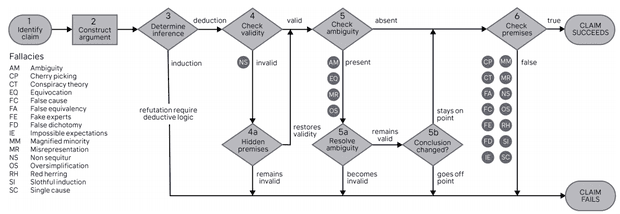
Climate myths are often contradictory – it’s not warming, though it’s warming because of the sun, and really it’s all just an ocean cycle – but they all seem to share one thing in common: logical fallacies and reasoning errors.
John Cook, Peter Ellerton, and David Kinkead have just published a paper in Environmental Research Letters in which they examined 42 common climate myths and found that every single one demonstrates fallacious reasoning. For example, the authors made a video breaking down the logical flaws in the myth ‘climate changed naturally in the past so current climate change is natural.’
Cook has previously published research on using ‘misconception-based learning’to dislodge climate myths from peoples’ brains and replace them with facts, and beating denial by inoculating people against misinformers’ tricks. The idea is that when people are faced with a myth and a competing fact, the fact will more easily win out if the fallacy underpinning the myth is revealed. In fact, these concepts of misconception-based learning and inoculation against myths were the basis of the free online Denial101x course developed by Cook and colleagues.
Denial101x lecture on inoculation theory by John Cook.
The new paper published today suggests an even more proactive approach to defeating myths. If people can learn to implement a simple six-step critical thinking process, they’ll be able to evaluate whether climate-related claims are valid.
Step 1: Identify the claim being made. For example, the most popular contrarian argument: “Earth’s climate has changed naturally in the past, so current climate change is natural.”
Step 2: Construct the argument by identifying the premises leading to that conclusion. In this case, the first premise is that Earth’s climate has changed in the past through natural processes, and the second premise is that the climate is currently changing. So far, so good.
Step 3: Determine whether the argument is deductive, meaning that it starts out with a general statement and reaches a definitive conclusion. In our case, ‘current climate change is natural’ qualifies as a definitive conclusion.
Step 4: Check the argument for validity; does the conclusion follow from the premises? In our example, it doesn’t follow that current climate change must be natural because climate changed naturally in the past. However, we can fix that by weakening the conclusion to “the current climate change may not be the result of human activity.” But in its weakened state, the conclusion no longer refutes human-caused global warming.
Step 4a: Identify hidden premises. By adding an extra premise to make an invalid argument valid, we can gain a deeper understanding of why the argument is flawed. In this example, the hidden assumption is “if nature caused climate change in the past, it must always be the cause of climate change.” Adding this premise makes the argument logically valid, but makes it clear why the argument is false - it commits single cause fallacy, assuming that only one thing can cause climate change.
Step 5: Check to see if the argument relies on ambiguity. For example, the argument that human activity is not necessary to explain current climate change because natural and human factors can both cause climate change is ambiguous about the ‘climate change’ in question. Not all climate change is equal, and the rate of current change is more than 20 times faster than natural climate changes. Therefore, human activity is necessary to explain current climate change.
Step 6: If the argument hasn’t yet been ruled out, determine the truth of its premises. For example, the argument that “if something was the cause in the past, it will be the cause in the future” is invalid if the effect has multiple plausible causes or mechanisms (as with climate change). In our example, this is where the myth most obviously falls apart (although it had already failed in Step 4).

Flowchart for evaluating contrarian claims. Circles indicate possible fallacies to be detected at each stage. Illustration: Cook et al. (2018), Environmental Research Letters
The authors suggest that their six-step critical thinking process can be deployed via social media through ‘technocognition,’ and in the classroom. Co-author David Kinkead from the University of Queensland said:
Posted by dana1981 on Tuesday, 6 February, 2018
 |
The Skeptical Science website by Skeptical Science is licensed under a Creative Commons Attribution 3.0 Unported License. |